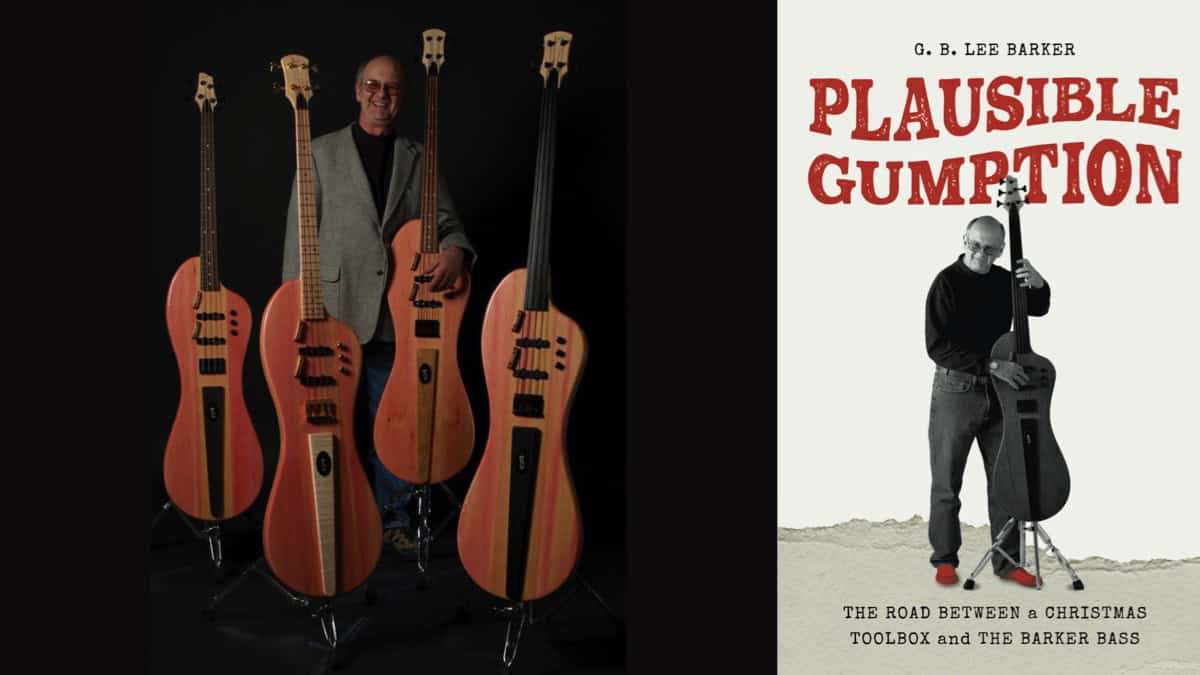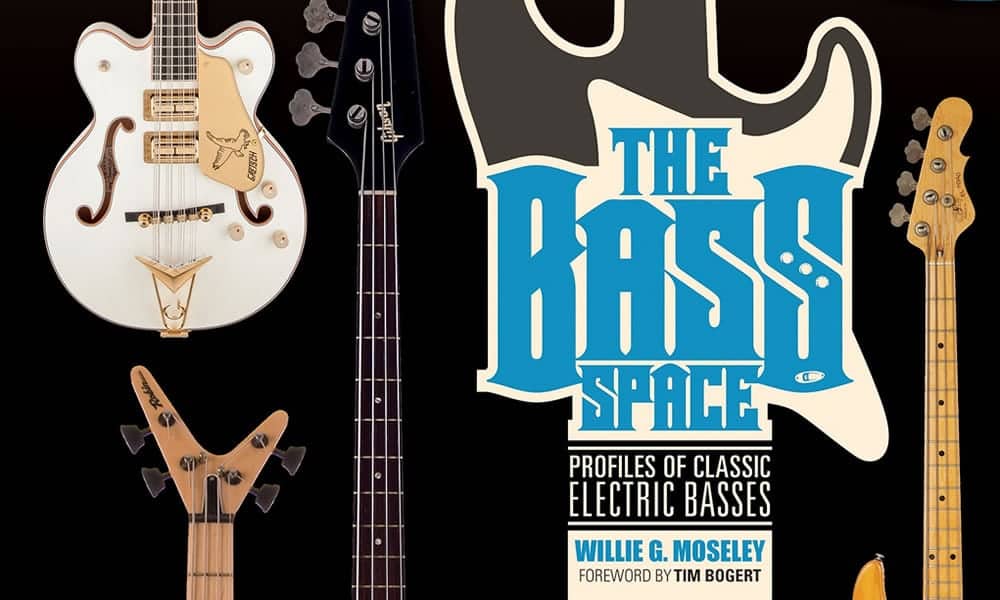Bass Books
New Bass Tapping Book by Jean Baudin
 Acclaimed solo bassist Jean Baudin today announced the release of “The Mechanics of Tapping” – an instructional guide on two-handed bass tapping. Baudin, one of the world’s most recognizable bass players as a pioneer of the extended range bass, is known for his unique, dark, melodic compositions using his two-handed tapping method. Baudin first received worldwide acclaim in the ‘90s as the founding member and creator of Nuclear Rabbit and later Element of Surprise. He has more recently garnered attention for his debut solo CD released in 2008, “Solace.” From teaching bass lessons and leading clinics all over the world, Baudin has documented his tapping techniques and exercises in this 58-page manual.
Acclaimed solo bassist Jean Baudin today announced the release of “The Mechanics of Tapping” – an instructional guide on two-handed bass tapping. Baudin, one of the world’s most recognizable bass players as a pioneer of the extended range bass, is known for his unique, dark, melodic compositions using his two-handed tapping method. Baudin first received worldwide acclaim in the ‘90s as the founding member and creator of Nuclear Rabbit and later Element of Surprise. He has more recently garnered attention for his debut solo CD released in 2008, “Solace.” From teaching bass lessons and leading clinics all over the world, Baudin has documented his tapping techniques and exercises in this 58-page manual.
“The two-handed tapping method is powerful for bassists who want to add a new dimension to their bass playing,” Baudin said. “Over the years, I have taught lessons and led master classes and clinics to help bass players learn my unique method of two-handed tapping. This book walks players through the technique and provides exercises to help them develop the skills to create and play two-handed tapping parts to create more dynamic bass parts and compositions.”
The new handbook, which also includes exercises to build finger stamina, makes Baudin’s tapping master-class techniques accessible to anyone who downloads the book.
“With this book Jean has created an excellent resource for mastering the tapping technique. His well-constructed methodology takes you from basic to complex tapping patterns with a personal style that’s both informative and entertaining. I recommend it for anyone who’s looking to expand their musical horizons.” – Michael Manring
“I was lucky enough to have one-on-one lessons with Jean and it has taken my bass playing to a whole new level!” said Brandon Smart, a student from Fresno, California. “My finger strength and stamina increased 100 percent with the exercises he has taught me, and now I can tap very tricky arpeggios and tunes with ease. No matter what style of music you play, Jean can open your eyes to new ways of playing it.”
“Attending Jean’s Master class on tapping in Paris was a major boost for me both technically and personally,” said Glen Clodore, a student from New Castle, Great Britain. “Jean’s didactic approach, his drive and passion were an incredible recipe for success; No one in the room wanted this master class to end! I particularly appreciated the fact that Jean managed to spend some time with each one of us, giving personalized advice and tips and sharing his valuable experience when we were practicing the different exercises. The material covered was cleverly selected and prepared so that regardless of our initial knowledge of tapping each of us could quickly use the concepts and technique in our own playing, I still use the provided booklet for reference. Strongly recommended!”
About Jean Baudin
Jean Baudin has performed solo bass shows and taught at clinics across the US and in Europe, including some alongside bass legends Stu Hamm and Michael Manring. Primarily self-taught, Baudin began playing the bass in 1985 and later received bass lessons from virtuoso guitarist Marty Friedman (solo artist, guitarist for MegaDeth) and Jason Becker (solo artist, member of David Lee Roth Band). Baudin first received worldwide acclaim in the ’90s as the founding member and creator of the underground California band Nuclear Rabbit and later Element of Surprise. Baudin also gained recognition for pioneering use of extended-range basses, basses with frequencies extending beyond the typical 4- or 5- string range. Baudin moved to a 6-string in 1996, a 9-string in 1999, and an 11-string in 2004. Baudin created a two-handed tapping style that fully utilizes this full range of low, deep bass notes, as well as high treble notes – enabling him to play multiple parts at once, similar to how a pianist can play a melody and a harmony or bassline at the same time. Adding pedal effects creates a multi-instrument affect, often dazzling listeners by how only one person is creating so much sound.
Baudin’s solo bass videos on youtube have garnered more than 13 million views. His “Solace” solo bass debut CD is now available in either CD or MP3 Download. The CD fully explores Baudin’s diverse range and skill, including the delicate, clear innocence of “Vanishing,” to the haunting sounds of “Frosty Acres” to the heavy, powerful “Krackatoa.” The solo compositions were recorded by Baudin without overdubbing, so live performances bring these songs to life.
Baudin is endorsed by Conklin guitars, Accugroove speaker cabinets, Ernie Ball, La Bella strings, BOSS effects, Ken Lawrence Instruments, Phil Jones Bass speakers, and Milennia Media.
Bass Books
Interview With Barker Bass’s Inventor and Writer Lee Barker

If you are an electric bass player, this is an exciting time to be alive as this relatively new instrument evolves around us. Some creative individuals have taken an active role in this evolution and made giant leaps in their own direction. Lee Barker is one of these inventive people having created the Barker Bass.
Fortunately, Lee is also an excellent writer (among so many talents) and has recently released his book “Plausible Gumption, The Road Between a Christmas Toolbox and The Barker Bass”. This book is a very fun read for everyone and shares a ton of details about Lee’s life in general, his experiences as a musician, a radio host, and a luthier. Now I am fortunate to have the great opportunity to gain even more insights into this renaissance man with this video interview.
Plausible Gumption, The Road Between a Christmas Toolbox and The Barker Bass is available online at Amazon.com
Bass Books
Ultimate Look at Electric Basses from 1930 to Today

The Bass Space: Profiles of Classic Electric Basses.
The definitive book for lovers of the low-end. Willie G. Moseley, Senior Writer for Vintage Guitar Magazine, profiles more than 100 historic and unique electric bass models from such makers as Alembic, Danelectro, Fender, Gibson, Gretsch, Guild, Hamer, Kramer, Rickenbacker, and many others.
Rare and legendary instruments, from the earliest attempts at amplified basses in the mid-1930s to the cutting-edge instruments of today, are presented in more than 250 color and period photos.
The main feature of this book is the exclusive coverage of historic and one-of-a-kind basses owned and played by such famed musicians as: Bill Black (Elvis Presley), Tim Bogert (Vanilla Fudge), Mark Egan (Pat Metheny Group), John Entwistle (The Who), Paul Goddard (Atlanta Rhythm Section), Bruce Hall (REO Speedwagon), Greg Lake (Emerson, Lake & Palmer), Benjamin Orr (The Cars), Tom Petersson (Cheap Trick), Carl Radle (Derek and the Dominos), Gene Simmons (Kiss), Steve Wariner, and others.
The Bass Space: Profiles of Classic Electric Basses is available online at Amazon.com
Bass Books
Review: The Bastard Instrument, A Cultural History of the Electric Bass by Brian F Wright

I was intrigued when The Bastard Instrument showed up on my desk… let’s dig in!
When we dive into the history of our beloved instrument, the bass, we find roots that go back as far as the 15th century. This instrument was a member of the violin family and was for the longest time, an acoustic instrument. As the years passed and music changed, there was a need for the instrument to evolve and the electric bass was born.
Comparatively, the electric bass is a relatively new instrument with its earliest appearances dating back to the 1930s and it is exciting to be an electric bass player while this history unfolds around us. Fortunately for us and future generations to come, Professor Brian F. Wright has taken on the herculean task of documenting the trajectory of the electric bass with this excellent book.
The Bastard Instrument presents an extraordinary amount of fine details about the instrument itself, the development of the amplification to handle its output, the pioneers that dared play it, the rapidly evolving music that flourished because of its presence and so much more.
When I first started reading this book, I noticed that it felt a tad academic, like a textbook (it might be one someday) or a doctoral thesis, but to present all this information accurately, this approach is more than appropriate. Another detail that might be a bit of a spoiler is that the book only gets us up to the late ’60s. I was left wanting more as we know that so much has happened in the bass world since that time frame; I hope there is another volume in the works to get us up to the present!
All in all, “The Bastard Instrument, A Cultural History of the Electric Bass” is a must-read for all of us who play electric bass and understand its essential place in music.
I found that there was a lot that I already knew but also quite a bit that I was unaware of. I believe that to know and understand where you are, you must know the history of exactly how you got here.
Highly recommended.
The Bastard Instrument is available at Amazon.com (beginning July 2024)
Bass Books
Review: The Bassist’s Complete Guide to Injury Management, Prevention and Better Health

The Bassist’s Complete Guide to Injury Management, Prevention and Better Health
I have often thought that it would be great if the doctors who delivered us as newborn babies provided us with a user manual to help us navigate through life in the best way possible. Now Dr. Randall Kertz, D.C. has produced a manual specifically designed to address the many possible afflictions plaguing us bass players.
Many of you will remember volumes 1 & 2 of this book and our first review in 2007. The new complete guide combines the two volumes and features over 20 pages of new material including interviews, techniques, and conditions.
If you play bass, you can read this book cover to cover and walk away with a ton of relevant and helpful knowledge. Another option is to search out issues relevant to you specifically (I found quite a few of my own with helpful options). This is possible because the book is very nicely organized into six chapters that address Pain, Conditions, Techniques, Road Issues, Inspirational Q&A with some of the biggest names in the bass community (too many to list here) and finally How to get relief.
All said, this book is essential if you play either electric or upright bass to the point where they should issue you one when you get that first bass in your hands.
Lastly, if you have this book and you have specific questions, Dr. Kertz is readily available through his website, www.drkertz.com. As if that was not enough, he has a wealth of knowledge you can find right here on our website at bassmusicianmagazine.com/author/randallkertz
Get this book… Live long and play bass well into the years! Available on Amazon.com
Bass Books
The Bassist’s Complete Guide to Injury Management, Prevention & Better Health

The Bassist’s Complete Guide to Injury Management, Prevention & Better Health is now available!

A compilation of Volumes 1 & 2 of the acclaimed Bassist’s Guide with 20+ pages of new interviews, techniques, and conditions, The Complete Guide puts everything in one convenient place.
Available at Amazon.com and from our friends at Bassline Publishing
Follow Dr. Kertz’s Bass Player Health at Bass Musician Magazine













